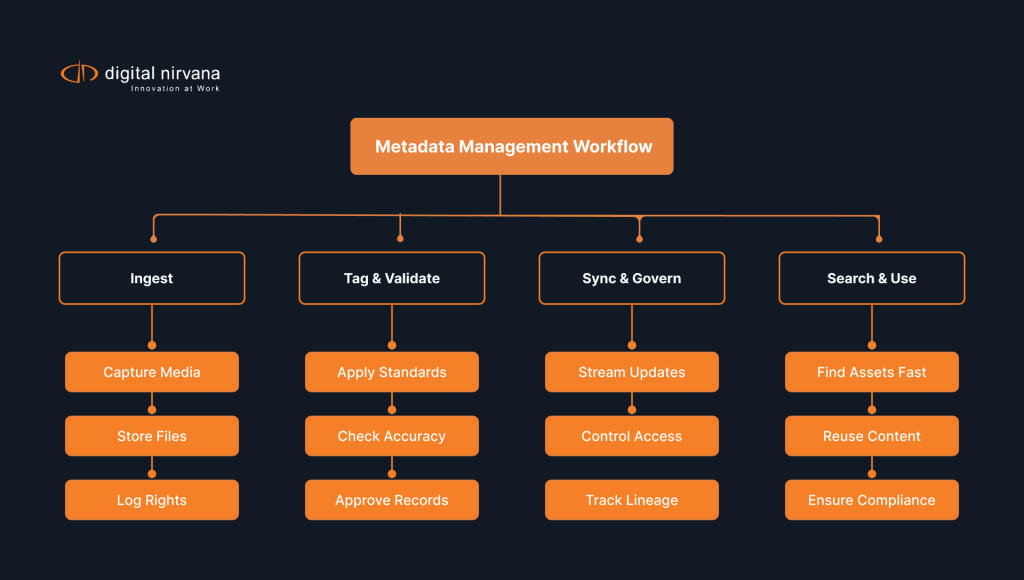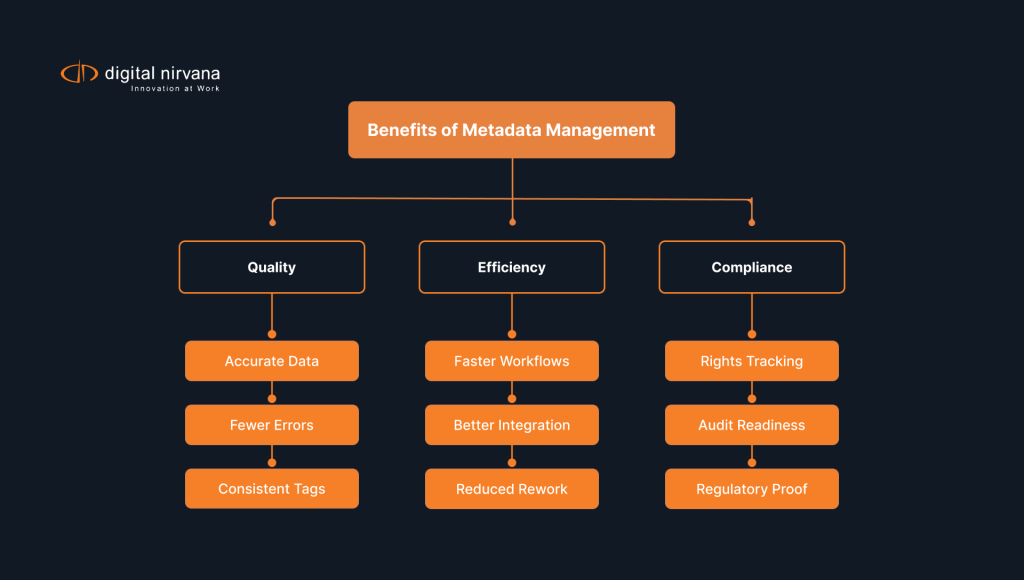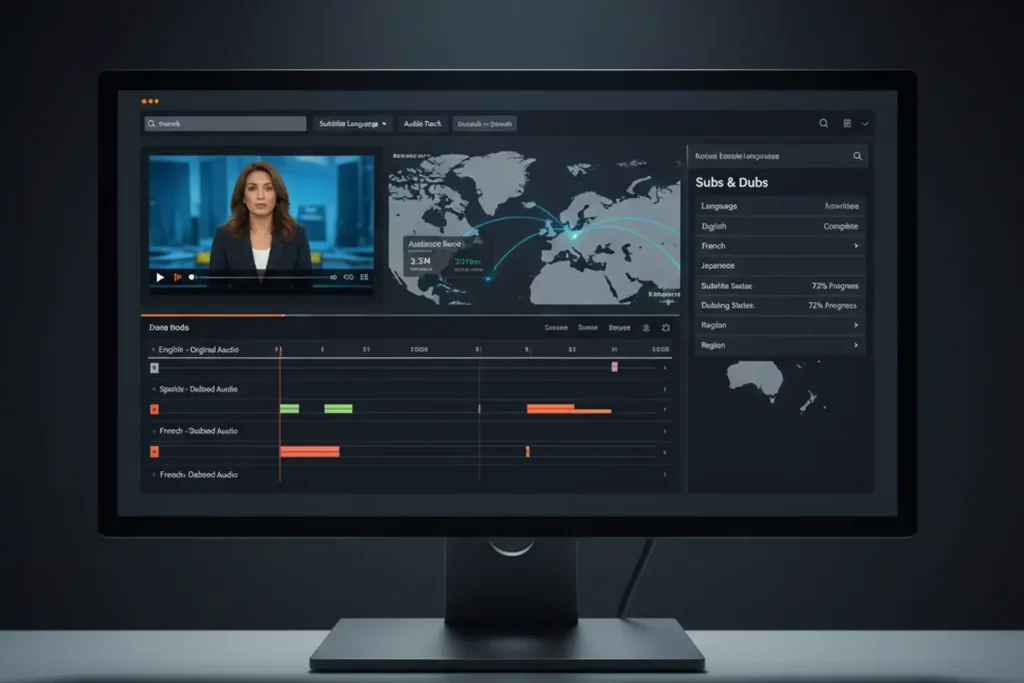Broadcasters juggle massive video archives, tight air dates, and strict rules from regulators such as the FCC captioning rules. Missing metadata can stall edits, hamper search, or trigger fines. Top stations label every clip at ingest, track lineage through playout, and surface assets in seconds. They rely on metadata software that syncs with traffic, MAM, and compliance logs so editors and engineers can find what they need without hunting. This guide reviews the best options, highlights essential features, and explains how to pick the right tool for your newsroom.

What Is Metadata Management and Why It Matters
Metadata management keeps every file, segment, and live feed searchable, trusted, and aligned with business policy. It connects technical and editorial teams so they can work from the same facts.
Defining Metadata in the Context of Enterprise Data
Metadata describes data. In broadcast, that means program names, segment IDs, rights windows, and loudness targets. Editors use it to pull B‑roll. Automation systems cue breaks with it. When you embed rich metadata at capture, you give every stakeholder the context they need to do the job fast. Structured tags beat scribbled notes on a drive. For deeper tactics, see our blog on AI metadata tagging.
The Role of Metadata in Data Discovery and Governance
Clear metadata turns terabytes of footage into an organized library. Search engines crawl tags, not video frames. Managers set retention rules based on rights fields and purge expired content automatically. A strong governance model assigns ownership so no one disputes who updates descriptive fields or quality flags. If you want examples of how this boosts discovery, read our guide on video metadata and engagement.
How Metadata Management Supports Regulatory Compliance
Regulators demand proof of what aired. Metadata tracks versions, language tracks, captions, and advertiser approvals. When the FCC requests an aircheck, you pull it by ID, show the related compliance log, and close the inquiry within hours. You can review captioning expectations on the FCC’s site and the CALM Act rules for ad loudness (captioning, CALM Act). For caption workflows, see our article on accurate captioning. Risk fines without proper metadata.

How Digital Nirvana Helps Broadcast Teams Move Faster
Our services at Digital Nirvana connect the dots from ingest to archive so teams work from a single source of truth. MetadataIQ auto-tags content, syncs fields across PAM and MAM, and accelerates search in fast-paced newsrooms. MonitorIQ captures airchecks, validates captions, and anchors compliance logs you can export in seconds. TranceIQ streamlines transcription and captions while feeding clean metadata back into your library. Explore our broader media and broadcasting AI solutions to integrate these products with your existing stack and training.
Benefits of Using Metadata Management Solutions
Well‑built solutions turn metadata from a chore into a productivity driver. They remove manual steps and give every department reliable information.

Improved Data Quality and Accuracy
Automated validation checks catch blank fields and mismatched codes before they cause trouble downstream. You feed traffic codes once and reuse them across MAM, playout, and archive, avoiding typos and duplicates. For a practical playbook, start with our post on AI metadata tagging for asset search.
Better Data Governance Across Teams
Role‑based workflows assign clear ownership. Engineers handle technical metadata, while producers fill creative fields. Approval gates lock records after QC so no one overwrites critical data.
Enhanced Operational Efficiency for Analytics and Reporting
Analytics teams crunch clean metadata to spot audience trends. Reports that once took days now run in minutes because the data is structured and current. For a deeper look at monitoring data that feeds these reports, explore our guide to a digital broadcast monitoring system.
Easier Integration with Data Lakes and Warehouses
Modern tools publish metadata through open APIs or event streams. Data engineers pipe these feeds into lakes and BI dashboards without writing brittle scripts.
Core Features to Look for in Metadata Management Software
Not all platforms fit broadcast needs. Focus on features that handle high‑volume media, tight turnarounds, and compliance demands.
Active Metadata and Real‑Time Updates
Active systems push changes instantly to connected apps. Platforms like MetadataIQ stream context to your PAM, MAM, and OTT stack so listings and archives agree. When an editor fixes a title, the change flows to the archive and the OTT CMS at once, eliminating mismatched listings.
Data Lineage Tracking and Impact Analysis
Lineage graphs show every transform from ingest to distribution. With MonitorIQ, compliance teams trace aired assets back to sources and verify logs with confidence. When you plan a format change, you use impact analysis to see which downstream jobs will break before you flip the switch.
Business Glossary and Metadata Cataloging Tools
A built‑in glossary defines each field in plain language. New hires learn that “House ID” means the unique asset code, not a location. Catalog views let users browse collections without logging into the MAM.
Role‑Based Access and Sensitive Data Controls
Rights managers restrict who edits contract dates, while engineers lock codec parameters. Sensitive fields like talent fees stay encrypted and audit‑logged.
Machine Learning Capabilities for Automated Metadata
AI models detect faces, logos, and speech, then suggest tags. For hands-on guidance, read our explainer on AI metadata tagging. Operators review suggestions instead of typing from scratch, which speeds up delivery and boosts consistency.
Trends in Metadata Management Across Enterprises
The market evolves fast. Successful teams track these shifts and plan upgrades accordingly.
The market evolves fast. Successful teams track these shifts and plan upgrades accordingly.
Shift from Passive to Active Metadata Systems
Legacy systems stored static tags. Modern platforms stream changes so BI dashboards and playout lists stay current without nightly batches.
Cloud‑Native Metadata Platforms for Modern Data Stacks
Public cloud archives lower storage costs and speed global access. Digital Nirvana’s media and broadcasting AI solutions support elastic scaling while keeping compliance intact. Vendors now offer SaaS catalogs that scale elastically during sporting events and shrink after wrap.
Growth of AI‑Ready Data and Self‑Service Data Catalogs
AI models need labeled data. Clean metadata feeds training pipelines while self‑service portals let analysts find assets without IT tickets.
Rise of Open Source and Vendor‑Neutral Solutions
Open schemas like Media Object Server (MOS) and IMF encourage interoperability. Broadcasters avoid lock‑in by choosing tools that embrace standards.
How Automation Transforms Metadata Management Workflows
Automation moves metadata work from spreadsheets to event‑driven pipelines.
Automated Data Profiling and Tagging
The system scans incoming files, identifies frame rates, audio channels, and speech segments, then fills technical fields faster than any operator can. To modernize this pipeline in monitoring, see how teams extend capabilities in our post on MonitorIQ 7.0.
AI‑Driven Change Management and Metadata Suggestions
When producers upload a trailer, the AI suggests genre and rating tags based on similar content. Editors accept or fix with one click, cutting keystrokes by half.
Impact of Automation on Cost and Resource Optimization
Automation frees operators from repetitive entry. Teams redeploy talent to creative tasks like highlights and social clips. The station saves on overtime and reduces errors that lead to rework.
Choosing the Right Metadata Management Tool for Your Needs

Tool selection should align with business goals and future growth.
Aligning with Your Data Strategy and Governance Framework
Map your data strategy first. If you aim for real‑time personalization, pick a platform with active metadata streaming and rich APIs.
Comparing Open Source vs. Commercial Metadata Platforms
Open source offers flexibility and no license fees, but you own maintenance. Commercial suites deliver support, roadmaps, and turnkey integrations. Balance control and resources before you decide.
Total Cost of Ownership and Vendor Support Considerations
Consider subscription, infrastructure, and people costs. A cheaper license may hide high integration fees. Check vendor SLAs, upgrade paths, and local support hours.
Ensuring Scalability for Future Data Growth
Choose a tool that handles 4K today and 8K tomorrow. Look for sharded databases, microservices, and autoscaling policies that keep performance steady as libraries grow.
Common Questions About Metadata Management Tools
Readers often ask how metadata software fits into existing broadcast pipelines.
What is the difference between active and passive metadata?
Active metadata updates instantly across connected systems. Passive metadata sits static until a batch job copies changes. Active models suit live TV where updates cannot wait.
How does metadata management improve data analytics?
Clean metadata feeds BI dashboards with accurate context. Analysts spend less time cleansing data and more time spotting trends that grow ratings.
Can metadata software help with data integration?
Yes. Modern platforms expose APIs and connectors that sync tags with MAM, CMS, and traffic systems. They serve as the single source of truth for asset context.
What types of organizations benefit most from metadata tools?
Any team that handles large media libraries gains value. Broadcasters, OTT providers, sports leagues, and news agencies all improve search, compliance, and monetization.
Are free trials available for enterprise metadata platforms?
Many vendors offer pilot licenses or proof‑of‑concept programs. Use these periods to test integrations, performance, and user adoption before a full rollout.
Why Digital Nirvana Fits Enterprise Metadata Goals
At Digital Nirvana, we help you turn metadata into measurable results. MetadataIQ raises data quality with AI-assisted tagging and validation. MonitorIQ reduces audit time and simplifies regulatory responses with searchable airchecks and reports. TranceIQ speeds multilingual captioning and description so global versions ship on time. Our media and broadcasting AI solutions team supports integrations, training, and rollout planning so adoption sticks.
In summary…
Broadcast teams thrive on fast access to well‑described content. The right metadata platform ties ingestion, production, and delivery into a seamless flow.
- Why it matters: Strong metadata drives search, compliance, and monetization.
- Key benefits: Better data quality, governance, and efficiency.
- Must‑have features: Active updates, lineage, glossaries, and AI tagging.
- Market trends: Cloud‑native, AI‑ready, and open standards.
- Automation impact: Cuts manual work and redirects talent to creative tasks.
- Selection tips: Align with strategy, weigh total cost, and plan for scale.
Adopt a solution that fits your workflow today and scales with tomorrow’s formats. When metadata flows freely, your content reaches audiences faster and yields higher returns.
FAQs
Q: How long does it take to implement a metadata management system?
A: Small pilots start in weeks, while full enterprise rollouts can span three to six months depending on integrations and training.
Q: Do I need dedicated staff to maintain metadata quality?
A: A data steward or librarian helps enforce standards, but automation and role‑based workflows reduce daily overhead.
Q: Can metadata tools capture live broadcast events in real time?
A: Yes. Modern platforms ingest live feeds, generate speech‑to‑text, and attach tags as the event airs, enabling near‑real‑time highlights.
Q: How does metadata software handle multilingual content?
A: Leading systems store language codes and support machine translation for titles and descriptions, ensuring accurate localization.
Q: What security measures protect sensitive metadata?
A: Encryption at rest and in transit, audit trails, and granular permissions guard rights info, talent contracts, and private notes.




